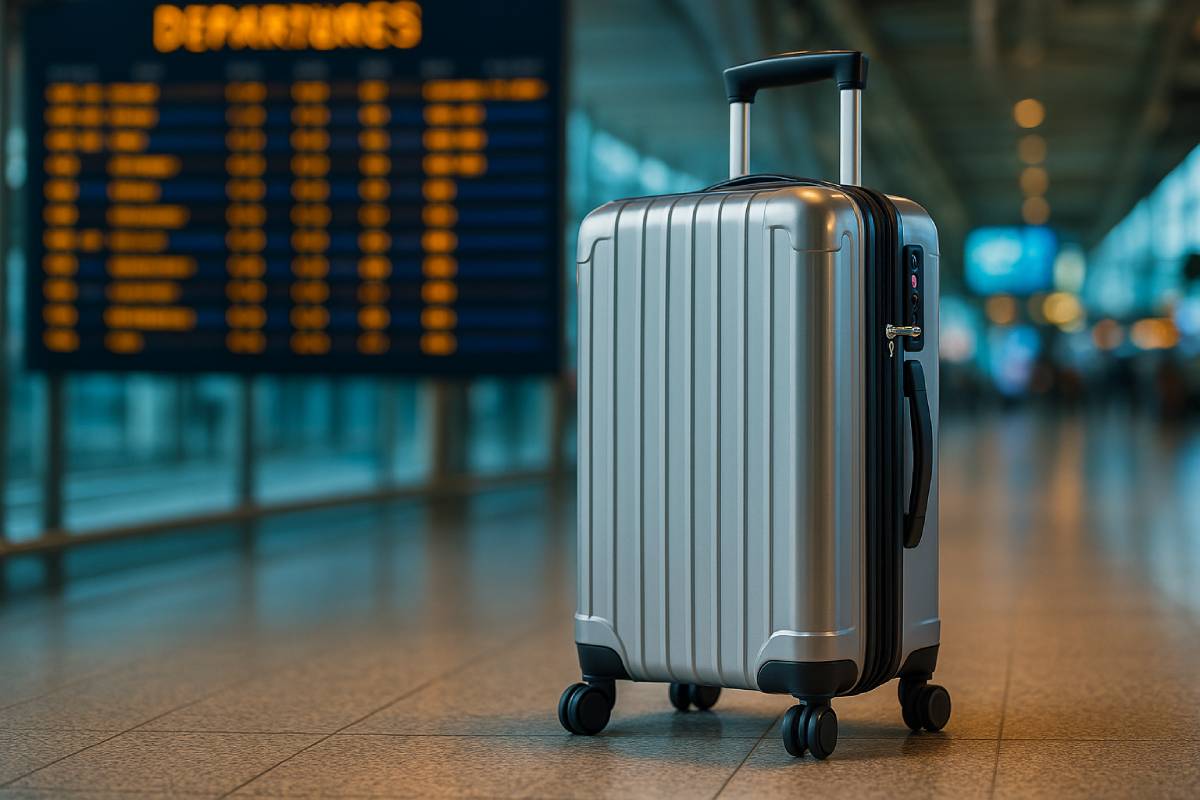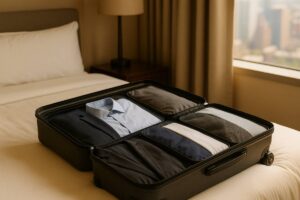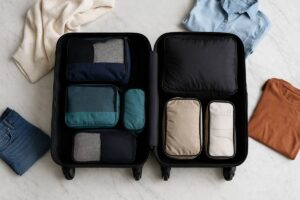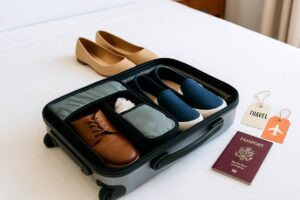Jetting off abroad shouldn’t mean gate-check headaches. With IATA rolling out a global 22 × 14 × 9 inch carry-on standard in March 2025, understanding size rules, airline quirks, and must-have features is critical for stress-free travel.
From weight caps—unlimited in the U.S. but often 7–10 kg overseas—to hard-shell vs. soft-sided trade-offs, we’ve tested durability, TSA-approved locks, quick-access pockets, and RFID protection.
We’ll also decode warranty fine print (Briggs & Riley’s “Simple as That” lifetime cover vs.
Tumi’s 5-year limit), then recommend the perfect bag for business pros, budget adventurers, space hunters, or ultra-light flyers.
Let’s streamline your carry-on decision—bin fit guaranteed.
Understanding Carry-On Luggage Standards
Most airlines base their cabin-bag policy on IATA’s voluntary guidelines, which call for a maximum of 22 in (56 cm) length × 18 in (45 cm) width × 10 in (25 cm) depth (including wheels, handles, pockets) to ensure smooth bin stowage.
In practice, carriers have standardized on a slightly narrower profile—22 × 14 × 9 inches (56 × 36 × 23 cm), measured end-to-end—balancing bin fit with useful capacity.
Beginning March 2025, IATA will formally recommend this 22 × 14 × 9 inches standard for all interline travel to harmonize carry-on rules across partners.
IATA Recommended Dimensions
IATA’s Baggage Reference Manual suggests carry-on dimensions not exceed 22 in (56 cm) × 18 in (45 cm) × 10 in (25 cm), including all protrusions like wheels and handles.
However, most airlines have converged on a de facto standard of 22 × 14 × 9 inches (56 × 36 × 23 cm), ensuring consistent overhead-bin compatibility and avoiding gate-check hassles.
- New 2025 IATA global standard: Starting March 2025, IATA partners will align on the 22 × 14 × 9 inches limit to streamline international connections.
Domestic vs. International Variations
While IATA provides guidance, individual markets still show variation—especially in the U.S. and Europe. Understanding these international rules helps travelers select bags that work across all airlines.
U.S. Domestic Allowances
Most major U.S. carriers follow the 22 × 14 × 9 inches rule without an explicit weight cap; exceptions like Southwest provide extra room:
| Airline | Size Limit (L × W × D) | Weight Limit |
|---|---|---|
| American Airlines | 22 × 14 × 9 inches | Not specified |
| Delta Air Lines | 22 × 14 × 9 inches | Not specified |
| United Airlines | 22 × 14 × 9 inches | Not specified |
| JetBlue Airways | 22 × 14 × 9 inches | Not specified |
| Hawaiian Airlines | 22 × 14 × 9 inches | 25 lb (11 kg) |
| Frontier Airlines | 24 × 16 × 10 inches (fees) | 35 lb (16 kg) |
| Southwest Airlines | 24 × 16 × 10 inches | Not specified |
Source: Travel + Leisure, updated March 25, 2025
European Weight Caps & Size Nuances
In Europe, airlines often cap carry-on weight between 7 and 10 kg, with slight dimension tweaks:
- Finnair (Domestic): 55 × 40 × 20 cm; max 7 kg (15 lb)
- Austrian Airlines: 55 × 40 × 23 cm; max 8 kg (17.6 lb)
- Lufthansa: 55 × 40 × 23 cm; max 8 kg (17.6 lb)
- Eurowings (SMART Fare): 55 × 40 × 23 cm; max 8 kg (17.6 lb)
These limits reflect cabin-space management and boarding speed priorities common across European carriers.
By understanding both IATA’s baseline and market-specific rules, travelers can select a carry-on that reliably fits bins and meets weight requirements—no surprises at the gate.
Major Airline Carry-On Policy Comparison
Most U.S. carriers adhere closely to IATA’s 22 × 14 × 9-inch guideline, with Southwest allowing a slightly roomier 24 × 16 × 10 inches yet still imposing no formal weight cap. In Europe and among global network carriers, dimensions hover around 55 × 40 × 23 cm, but weight limits kick in—British Airways permits up to 23 kg per bag, Lufthansa caps economy carry-ons at 8 kg (two at 8 kg each in business/first), and Air France allows 12 kg total across hand baggage items.

Low-cost airlines split allowances between a small under-seat bag and an optional larger cabin bag, rigorously enforcing size requirements (e.g., Ryanair’s 40 × 20 × 25 cm personal bag plus a 55 × 40 × 20 cm overhead bag at 10 kg) and levying fees for non-compliance.
Regional specialists like Qatar Airways (one bag 50 × 37 × 25 cm at 7 kg in economy; two at 15 kg each in premium cabins) and Qantas (international economy: one 7 kg piece; premium cabins: up to 14 kg split across two items) tailor policies to long-haul markets.
U.S. Carriers
| Airline | Dimensions (incl. wheels & handles) | Weight Limit | Notes |
|---|---|---|---|
| American Airlines | 22 × 14 × 9 in (56 × 35 × 23 cm) | No limit | Standard across all cabins |
| Delta Air Lines | ≤ 45 linear in (114 cm); 22 × 14 × 9 in individual | No limit | Meets FAA rules; musical instruments excepted |
| United Airlines | 22 × 14 × 9 in (56 × 35 × 23 cm) | No limit | Must fit overhead bin |
| Alaska Airlines | 22 × 14 × 9 in (56 × 35 × 23 cm) | No limit | Plus one personal item |
| Southwest Airlines | 24 × 16 × 10 in | No limit | Includes handles; more generous sizing |
European & International Airlines
| Airline | Dimensions | Weight Limit | Notes |
|---|---|---|---|
| British Airways | 56 × 45 × 25 cm (22 × 18 × 10 in) | 23 kg per bag | Plus one small personal bag under the seat |
| Lufthansa | 55 × 40 × 23 cm | Economy 1×8 kg; Premium/Bus./First 2×8 kg each | Free baggage in cabin per class |
| Air France | 55 × 35 × 25 cm | Economy 12 kg total; Business/La Première 18 kg total | Includes one hand baggage + one small bag |
Low-Cost Carriers
- Ryanair: Free personal bag up to 40 × 20 × 25 cm; Priority boarding adds 55 × 40 × 20 cm cabin bag (10 kg). Strict gate-sizer enforcement, fees apply for oversize/overweight.
- easyJet: One small under-seat bag (45 × 36 × 20 cm, up to 15 kg) free; large cabin bag (56 × 45 × 25 cm, 15 kg) add-on or membership benefit; limited to two bags on board.
Regional Exceptions
- Qatar Airways: Economy: one carry-on 50 × 37 × 25 cm (≤ 7 kg); Business/First: two pieces same size (≤ 15 kg each).
- Qantas (International): Economy: one standard bag ≤ 7 kg; Premium cabins: one or two bags totalling up to 14 kg (e.g., two small bags ≤ 10 kg each).
By comparing these policies, you can pinpoint the right carry-on that fits both overhead bins and weight scales—key to stress-free international travel.
Size Charts & Dimension Infographics
At a glance, while IATA’s baseline guideline for carry-on luggage is 22 × 14 × 9 inches (56 × 36 × 23 cm), individual airlines tweak those dimensions slightly to optimize bin space and boarding efficiency.
Below, you’ll find a side-by-side comparison of IATA’s recommended maximum against the limits enforced by major carriers. Next, follow our step-by-step instructions for measuring your suitcase—protruding wheels, handles and pockets included—so you never get caught at the gate.
Finally, refer to our simple infographic outlining the three critical axes (22″ height × 14″ width × 9″ depth) to visualize exactly how your bag should nestle into virtually any overhead bin.
Visual guide to IATA vs. airline-specific limits
| Carrier / Standard | Max Dimensions (L × W × H) | Notes |
|---|---|---|
| IATA Recommendation | 22 × 14 × 9 in (56 × 36 × 23 cm) | Industry-wide guideline for interline consistency |
| American Airlines | 22 × 14 × 9 in (56 × 36 × 23 cm) | Must fit in sizer at gate; wheels & handles included |
| Delta Air Lines | 22 × 14 × 9 in (56 × 36 × 23 cm) | FAA regulation; no weight limit |
| United Airlines | 22 × 14 × 9 in (56 × 35 × 23 cm) | Include wheels/handles when measuring |
| Southwest Airlines | 24 × 16 × 10 in (61 × 41 × 25 cm) | More generous sizing; no formal weight cap |
| British Airways | 22 × 18 × 10 in (56 × 45 × 25 cm) | Cabin bag + personal item; weight ≤ 23 kg |
| Lufthansa | 21.7 × 15.7 × 9.1 in (55 × 40 × 23 cm) | Economy & Premium: 1× 8 kg; Biz/First: 2× 8 kg each |
| Air France | 21.7 × 13.8 × 9.9 in (55 × 35 × 25 cm) | Economy: 12 kg total; Biz: 18 kg total |
How to measure your bag properly (including protuberances)
- Lay your bag flat on a level surface to stabilize wheels and handles.
- Measure Height (22 in): From the bottom of the wheels up to the top of the telescoping handle when fully retracted.
- Measure Width (14 in): Side-to-side at the bag’s widest point, accounting for side pockets and grips.
- Measure Depth (9 in): Front-to-back at the thickest section, including any bumpers or zip-pockets.
- Include all protuberances: Wheels and handles must be within your measurements—airline sizers reject bags that only fit when squeezed.
- Verify in a gate sizer: Always test in the airport’s frame before boarding to avoid last-minute fees.
Pro Tip: Remove detachable straps or garment sleeves before measuring to trim inches off depth and height.
Infographic: 22 × 14 × 9 diagram with handles/wheels
scssCopyEdit ╔═════════════════════════════╗
║ Top View ║
║ (Width = 14") ║
╚═════════════════════════════╝
┌──────┐ ┌──────┐ ← Wheels
│ │ │ │
│ ┌─────────────────────────┐ │
│ │ Side View │ │
│ │ (Depth = 9") │ │
│ │ ┌─────────────────────┐ │ │
│ │ │ │ │ │
│ │ │ Bag Body │ │ │
│ │ │ │ │ │
│ │ └─────────────────────┘ │ │
│ │ │ │
│ │ (Height = 22") │ │
│ │ │ │
└──┴─────────────────────────┴──┘
↑ ↑
Handles Wheelbase
- Height (22″): measured from wheel base to top of handle.
- Width (14″): measured across front, side grips included.
- Depth (9″): measured from front pocket to back panel.
- Protuberances: wheels, handles and pockets must nest inside this box.
Use this visual as your template: if your bag fits these axes, you’ll breeze through gate checks and overhead-bin Tetris every time.
Hard-Shell vs. Soft-Sided Luggage
In choosing the right carry-on, balancing protection, packability, and practicality is key. Hard-shell suitcases—built from materials like ABS or polycarbonate—excel at guarding fragile items but tend to be heavier and non-expandable; soft-sided bags leverage high-density fabrics for lighter weight and flexible packing but can sacrifice some structural rigidity and long-term wear resistance.
Below, you’ll find a detailed pros/cons comparison, expert insights on durability, weight, expandability, repairability, and tailored recommendations for business, adventure, or budget-minded travelers.
Pros & Cons Comparison Table
| Feature | Hard-Shell | Soft-Sided |
|---|---|---|
| Durability | Excellent impact resistance; rigid shells absorb crushing forces; may crack under extreme stress | Fabric flexes under impact; high-density nylon/polyester resists abrasions but can tear if snagged |
| Weight | Typically 7–9 lbs empty for standard carry-ons; denser materials (aluminum) can exceed 10 lbs | Often 4–6 lbs empty for 22″–24″ bags, maximizing payload allowance |
| Expandability | Non-expandable (except spring-loaded systems up to +25 %) | Commonly includes 1.5–2″ zip-gussets for extra space; compacts when unzipped |
| Repairability | Cracks require professional shell replacement or kits; scuffs can be buffed out | Tears patched easily; zippers/handles are modular and often user-replaceable |
| Cost Range | $100–$500+ depending on materials and brand | $50–$300+ based on fabric quality and features |
Sources: Consumer Reports· Travelpro · Briggs & Riley · Good Housekeeping· Travel + Leisure · Eminent · New York Magazine · Rick Steves Forum.
Durability
Hard-shell carry-ons are prized for their ability to withstand drops, impacts, and rough baggage-handling environments thanks to resilient plastics like polycarbonate and ABS. Briggs & Riley’s modern hardshells even use multi-layer Makrolon® polycarbonate to blend elasticity with strength, reducing cracking risk under pressure.
Soft-sided luggage—when crafted from ballistic nylon or high-density polyester—bends under force rather than fracturing, and water-resistant coatings guard against rain and spills; however, inferior fabrics may rip at stress points.
Weight
Empty hard-shell carry-ons typically weigh between 7 and 9 lbs, with lightweight polypropylene variants on the lower end and aluminum models exceeding 10 lbs. In contrast, soft-sided bags average just 4–6 lbs when empty, giving you more room under strict airline weight caps and easier lifting into overhead compartments.
Expandability
Most hard-shell cases have a fixed volume, though premium lines like Briggs & Riley’s CX™ system expand up to 25 % before rebounding to original size. Soft-sided luggage often features zip-gussets that add 1.5–2 inches of depth for last-minute souvenirs, then collapse seamlessly when not in use.
Repairability
Soft-sided suitcases are easy to mend on the go: fabric tears can be patched, and external components like zippers and pockets are typically user-serviceable or replaceable. Hard-shell breaks—particularly shell cracks—require specialized kits or professional replacement, though minor scuffs buff out with a sponge or polish.
Recommended Use Cases
- Business Travelers: Aim for a sleek hard-shell spinner with integrated TSA locks and polished finishes. These guard laptops and documents while projecting a professional image—ideal for corporate travel.
- Adventure Travelers: Opt for rugged soft-sided duffel hybrids with reinforced fabric, external lash points, and expandable compartments to handle gear, muddy hikes, or wet conditions.
- Budget-Conscious Shoppers: Entry-level hardshell bags (e.g., Amazon Basics) under $100 offer surprising durability, while value soft-side options add pockets and expansion at low price points amazon.com.
By weighing these factors—durability, weight, expandability, and repairability—you’ll choose the carry-on that best fits your travel style, whether you’re jetting off for business, embarking on a rugged adventure, or simply hunting for the best value.
Weight Restrictions & Lightweight Options
Below is a detailed look at how carry-on weight limits vary worldwide, the materials and design tricks that keep your empty bag feather-light, and our top picks for ultra-light carry-ons.
Most international carriers cap cabin-bag weight at 7–10 kg, while nearly all major U.S. airlines impose no formal weight limit, focusing instead on size and your ability to lift the bag into the overhead bin. Lighter materials like polypropylene, polycarbonate, and high-denier nylon—paired with slim frames and spinner wheels—can shave pounds off your empty bag. Below, you’ll find:
- A quick comparison of international vs. U.S. weight policies
- Key materials & design features that reduce bag weight
- Top lightweight carry-on models to consider
Typical international weight caps (7–10 kg) vs. unlimited U.S. policies
| Region | Weight Limit | Notes |
|---|---|---|
| International Airlines | 7–10 kg | Common across Europe & Asia; e.g., European carriers 7–10 kg |
| U.S. Carriers (AA, Delta, United, Southwest) | No formal limit* | Must fit sizer & be liftable by passenger; no weight cap listed |
* Some exceptions at select airports (SIN: 7 kg; PEK/ PVG: 10 kg)
Materials and design features that reduce empty weight
- Shell Materials
- Polypropylene: the lightest plastic option, saving up to 1–2 lbs over ABS.
- Polycarbonate: slightly heavier than polypropylene but far more crack-resistant, with many cases weighing as little as 4 lbs.
- High-denier nylon/ballistic nylon: common in soft-sided bags; balances tear resistance with minimal weight.
- Frame & Handles
- Aluminum track handles (e.g., Travelpro PowerScope™ Lite) shave ounces compared to steel.
- Integrated frame designs eliminate excess internal bracing, reducing bulk without sacrificing strength.
- Wheels & Hardware
- 360° spinner wheels distribute weight evenly and often use hollow-core or polymer designs to cut down on metal weight.
- Minimalist hardware (low-profile locks, flush-mount pockets) trims unnecessary ounces.
- Internal Features
- Compression systems let you pack more without a heavier shell.
- Rip-stop linings and unbranded zippers avoid the heft of bulkier components.
Top lightweight carry-on picks
- Travelpro Maxlite® 5 Compact Carry-On Spinner
- Weight: 5.1 lbs (2.3 kg)
- Material: High-density polyester with DWR coating, Powerscope Lite aluminum handle
- Why it’s great: Ultra-light yet built to last—ideal for strict weight caps
- Away The Carry-On
- Weight: 7.5 lbs (3.4 kg)
- Material: Polycarbonate shell, interior compression system
- Why it’s great: Balances strength and packability, with award-winning design
- Travelpro Platinum Elite Hardside Spinner
- Weight: 7.8 lbs (3.5 kg)
- Material: Makrolon® polycarbonate shell, MagnaTrac® wheels
- Why it’s great: Premium durability and smooth handling for frequent flyers
- Tumi International Carry-On
- Weight: 11.0 lbs (5.0 kg)
- Material: Aluminum frame with polycarbonate & ballistic nylon panels
- Why it’s great: Exceptional build quality and style—worth the extra ounces
By choosing the right combination of lightweight materials, slim hardware, and streamlined design, you’ll maximize your packing potential while staying under those critical weight caps—whether you’re hopping across Europe or enjoying the freedom of U.S. domestic unlimited policies.
TSA- & Security-Friendly Features
Most modern carry-ons don’t just stash your gear—they safeguard it. Integrated TSA-approved locks ensure airport security can inspect without destroying your lock; quick-access pockets let you breeze through electronics and liquid checkpoints; and RFID-blocking, anti-theft zippers guard against digital and physical pick-pockets. Below, we’ll break down each feature, explain why it matters, and point you to models that get it right.
Integrated TSA-approved locks
What they are and why they matter
TSA-approved locks use a special mechanism recognized by U.S. and international security agencies, letting agents open and relock your bag without cutting off your lock. Integrated locks are built directly into the suitcase frame or shell—no dangling padlocks—so you never lose keys or fumble with separate lock attachments.
Key benefits
- Damage prevention: Your lock stays intact, and your bag isn’t flagged for a broken lock at the carousel.
- Global recognition: The red-diamond Travel Sentry logo on integrated locks means agents worldwide know exactly how to open them.
Quick-access compartments for electronics and liquids
Streamlining security checks
TSA rules require laptops out in a separate bin, and liquids in clear quart-sized bags—juggling both in a tight overhead can slow you down. Dedicated front-pocket compartments let you slide out your 13–15″ laptop or tablet without unzipping the main shell. Clear, zip-top pouches or mesh panels inside quick-access pockets keep your 3-1-1 liquids organized and visible—no digging for that quart bag under your sweater.
Feature comparison
| Feature | Benefit | Example Model |
|---|---|---|
| Padded laptop/tablet sleeve | Protects devices; instant removal | KYME 22″ Hardside (front laptop compartment) amazon.com |
| Clear liquids pocket | Meets TSA 3-1-1 without repacking | Away The Carry-On (interior mesh pouch) |
| External quick-grab pocket | Stash phone, passport, boarding pass | Travelpro Maxlite® 5 (easy-access organizer) |
RFID blocking & anti-theft zippers
Protecting against digital and physical theft
Some passports, credit cards, and boarding passes emit RFID signals that can be skimmed by thieves with portable readers. Integrated RFID-blocking linings create a Faraday cage around your pockets, jamming unauthorized scans and keeping personal data safe.
Meanwhile, locking or slash-resistant zippers deter pick-pockets and bag slashers—many brands include lockable sliders or cable-reinforced zipper tracks. Pacsafe’s patented eXomesh® wire-mesh lining under fabric panels also makes bags virtually cut-proof.
Anti-theft feature showcase
| Feature | Protection type | Example Brand/Model |
|---|---|---|
| RFID-blocking pocket | Digital skimming prevention | Baggallini Securtex® Sling |
| Lockable zipper sliders | Unauthorized opening deterred | TravelSmith RFID Anti-Theft Shoulder Bag |
| Slash-resistant fabric & straps | Physical cutting resistance | Pacsafe Venturesafe EXP Backpack |
| Double-cable locking zips | Combines zipper pulls | Baggallini anti-theft collection |
| RFID-blocking lining | Faraday-cage effect | Pacsafe Citysafe CX |
By choosing a carry-on with these TSA- and security-friendly features, you’ll save precious minutes at checkpoints, protect electronics and liquids, and keep personal data—and your peace of mind—secure from gate to gate.
Durability Testing & Warranty Information
Below is what you need to know to choose a carry-on that not only survives the rigors of travel but comes backed by a warranty and service policy you can trust. We’ll cover:
- What to look for in manufacturer warranties – lengths, coverage scope, and fine print
- Indicators of high build quality – the structural features that withstand rough handling
- Brands with the best long-term service policies – who stands behind their bags, and for how long
Across the board, warranties range from a 5-year limit (Tumi) to truly unconditional lifetime coverage (Briggs & Riley), while brands like Rimowa have even extended their lifetime policies to include airline damage as of 2023. Real-world durability is proven via standardized tests—SATRA’s five-hour “rolling-road” wheel stress test and Intertek’s strength checks on handles and buckles—so look for cases that cite these benchmarks.
Finally, features like reinforced aluminum-alloy corner guards, multi-layer polycarbonate shells, and ballistic-nylon panels aren’t just marketing copy—they’re the difference between a one-trip scratch and a ten-year workhorse.
What to Look for in Manufacturer Warranties
When comparing policies, focus on duration, what’s covered, and what’s excluded.
| Brand | Warranty Length | Coverage Highlights | Exclusions & Notes |
|---|---|---|---|
| Briggs & Riley | Lifetime (“Simple as That”) | All functional damage—including airline damage, no receipt needed | Cosmetic wear, stains, lost contents, normal wear & tear |
| Rimowa | Lifetime (since 2023)** | Defects & airline-inflicted damage; global service network | Scratches, dents from UV, misuse |
| Samsonite | 10-Year Limited Global | Manufacturing defects in materials & workmanship | Misuse, accidents, abrasion, normal wear, airline damage |
| Tumi | 5-Year Limited | Defects in materials & workmanship; first year all repairs covered | Wear & tear, cosmetic damage, theft, loss |
| Travelpro | Limited Lifetime | Defects in materials & workmanship only | No coverage for wear & tear; parts availability may be limited over time |
Pro Tip: Always register your bag online and keep the purchase receipt and warranty card—many brands require proof of purchase for service.
Indicators of High Build Quality
Beyond the fine print, inspect your carry-on for these structural hallmarks:
| Feature | Why It Matters | Where to Look |
|---|---|---|
| Reinforced Corner Protectors | Deflect impacts at stress points; prevent cracks | Metal or aluminum-alloy guards on all four corners |
| Multi-Layer Polycarbonate Shell | Combines flexibility with crack resistance | Brand specs (e.g., Makrolon® polycarbonate on Briggs & Riley) |
| Ballistic-Nylon Panels | Tear- and abrasion-resistant for soft-sided bags | High-denier fabric labels or product descriptions |
| Aluminum-Track Handles | Lightweight yet sturdy; resists bending | “PowerScope™ Lite” or similar on premium models |
| Double-Spinner Wheels | Smooth roll & even weight distribution | Check wheel housings; hollow-core or polymer-cored designs |
| Outsider® Handle & Zero-Interior Groove | Protects garment area from protrusions | Unique to Briggs & Riley; exterior handle channel |
Durability Testing: Look for references to SATRA TM249 “rolling-road” wheel tests (5 hr load/drop cycle) and Intertek’s buckle/strap strength protocols.
Brands with Best Long-Term Service Policies
These manufacturers top the charts for reliability—both in build and in backing their products.
| Brand | Warranty & Service Highlights | Why It Stands Out |
|---|---|---|
| Briggs & Riley | Unconditional lifetime guarantee—even covers airline damage; global repair network | “Simple as That” truly means no fine print; DIY kits & free return shipping |
| Rimowa | Lifetime coverage since 2023; luxury craftsmanship; dedicated Lipault® and atelier repairs | Covers structural & airline damage under LVMH umbrella; premium R&D labs |
| Samsonite | 10-year global warranty; approved service centers worldwide; paid out-of-warranty repairs available | Worldproof® performance testing; long-standing after-sales support |
| Tumi | 5-year limited warranty; first-year “all-repairs” coverage; Priority Tracer® lost-bag program | High customer satisfaction on workmanship; robust international network |
| Travelpro | Limited lifetime for defects; focused on airline crew–grade durability | Competitive lifetime defect coverage; trusted by flight crews |
By prioritizing comprehensive, easy-to-understand warranties, vetting structural reinforcements in your bag’s design, and choosing a brand renowned for after-sales service, you’ll invest in luggage that keeps you moving—trip after trip—without unexpected repair bills or gate-check headaches.
Product Recommendations by Travel Profile
Here’s a set of tailored carry-on recommendations to match your travel style—whether you need rock-solid durability for business, wallet-friendly ease for leisure, extra room for souvenirs, or feather-light freedom on weight-restricted routes.

Each pick delivers on size compliance and practical features, with specs you can trust from top travel authorities.
Premium Durability for Business Travelers
For executives and road warriors who demand reliability, these bags pair tough exteriors with pro-grade features from our tested picks.
| Model | Key Features | Notes |
|---|---|---|
| Travelpro Platinum Elite Expandable | Polycarbonate hardshell; MagnaTrac® spinner wheels; USB port; built-in TSA lock | Weighs 7.8 lbs; praised for surviving rugged “Texas ranch” field tests and daily corporate use. Rated BI’s top pick for frequent fliers thanks to capacity and attention to detail. |
| Tumi 19° International Expandable Carry-On | Ballistic-nylon shell; dual spinner wheels; 38 L capacity; front-lid expansion system | Lab-tested by Outdoor Gear Lab: 7.6 lbs with excellent impact resistance and three-height handle adjustment. Holds up with minimal scuffs after repeated trips according to T+L durability trials. |
| Rimowa Essential Cabin S | Makrolon® polycarbonate shell; ultra-light 4.9 lbs; groove design; Telescoping handle; TSA lock | Good Housekeeping’s lightest traditional hard side carry-on at 4.9 lbs, yet still resists dents and scratches in lab tests. Luxury-grade craftsmanship with a global service network. |
Budget-Friendly Models for Leisure Travelers
Affordable picks that won’t skimp on compliance or comfort—perfect for weekend getaways and off-season deals.
| Model | Price Point | Highlights |
|---|---|---|
| Amazon Basics Hardside Spinner | $50 – $70 | ABS shell; spinner wheels; built-in combination lock; fits 22×14×9″ |
| Rockland Melbourne Expandable | $53 .19 (Amazon) | 20″ hardshell; expandable +1″; 360° wheels; carry-on legal; under-$60 at major retailers |
| Béis The Carry-On Roller | $195 – $225 | Soft-sided nylon; corner bumpers; interior compression straps; built-in TSA lock; trending style at a value price point |
Best Expandable & Versatile Options
Need extra wiggle room for souvenirs or last-minute shopping? These expanders adapt on the go without gate-check drama.
| Model | Expansion | Why It Works |
|---|---|---|
| Samsonite Freeform Expandable Spinner | +1″ depth | T+L’s “Best Overall” with 6.5 lbs empty weight, surprising 47.9 L capacity, and 1″ expander for shopping hauls |
| Monos Carry-On Pro | +2″ hidden expander | Sleek polycarbonate; silent spinner wheels; built-in TSA lock; lifetime warranty; grows from 38 L to 42 L without changing size profile |
| Travelpro Platinum Elite Expandable | +2.5″ CX™ system | Premium polycarbonate; powerscope-lite aluminum handle; expand-and-rebound design preserves shape post-trip |
Ultra-Lightweight Designs for Weight-Sensitive Routes
When every ounce counts—especially on European and Asian carriers with 7–10 kg caps—go as light as possible.
| Model | Empty Weight | Stand-Out Feature |
|---|---|---|
| Rimowa Essential Cabin S | 4.9 lbs | The industry’s lightest polycarbonate shell, proven in Good Housekeeping labs |
| Samsonite Uplift Hardside Spinner | ~5 lbs | Lab-tested for maneuverability and durability; 360° spinner wheels; fits strict bins |
| Calpak Terra Carry-On | — | Named “Most Lightweight Carry-On” by Condé Nast Traveler; soft-shell flexes under seat if needed |
By matching your travel profile to one of these top-rated carry-ons—backed by real-world tests and expert reviews—you’ll breeze past gate checks, maximize packing power, and avoid surprises on your next international trip.
Conclusion
Navigating carry-on policies shouldn’t feel like decoding hieroglyphics. By anchoring your choice in IATA’s 22 × 14 × 9 inch interline standard, you sidestep last-minute gate checks and unexpected fees. In the U.S., loft weight worries vanish—focus instead on maneuverability and capacity—while international flyers must obey 7–10 kg limits to stay cabin-side.
Deciding between hard-shell’s rock-solid polycarbonate and soft-sided’s expandable nylon demands weighing durability, empty weight, and repair needs. Security features—TSA-approved locks, quick-access pockets, RFID-blocking linings—aren’t mere luxuries; they’re your frontline against delays and theft. And warranty fine print reveals true brand confidence: Briggs & Riley’s “Simple as That” lifetime guarantee covers airline damage, while Rimowa and Samsonite offer robust 10-year to lifetime plans.
Finally, whether you’re jetting for boardrooms, beach vacations, or cross-continent odysseys, our curated picks—ranging from Travelpro’s Platinum Elite to Amazon Basics’ budget spinner—ensure your carry-on fits the bin, your style, and your wallet. Equip yourself with these insights, and transform carry-on chaos into cabin-ready confidence on every trip.
FAQs
What are IATA’s standard carry-on dimensions?
IATA recommends a maximum 22 × 14 × 9 inch cabin bag—including wheels and handles—across interline itineraries from March 2025.
Can I bring a carry-on plus a personal item?
Yes. Most airlines allow one carry-on (22 × 14 × 9 inches) plus a personal item (e.g., purse, laptop bag) under 18 × 14 × 8 inches.
What if my bag is slightly overweight overseas?
International carriers enforce strict 7–10 kg limits. Overweight fees or gate-checked luggage may apply—always weigh before boarding.
Are hard-shell bags more durable than soft-sided?
Hard-shells resist crushing and impacts; soft-sided models flex under pressure and often include expanders. Your choice hinges on fragility vs. flexibility needs.
What warranty should I expect on a premium carry-on?
Top brands offer lifetime coverage on defects (Briggs & Riley, Rimowa), 10-year limited (Samsonite), or 5-year limited (Tumi). Check for airline-damage inclusions.
























